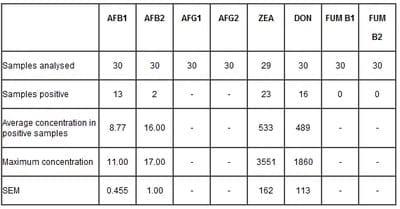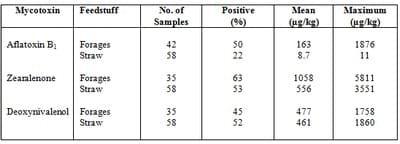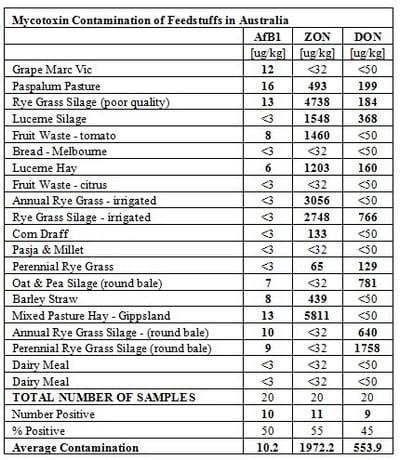Mycotoxins are secondary metabolites produced by fungi. When ingested by livestock, mycotoxins can cause production losses, ill thrift and reduced disease resistance. Initially the effects of mycotoxins may go unnoticed, however with prolonged ingestion the effects of mycotoxins can become more pronounced. The effects of mycotoxins range greatly depending on the mycotoxins present and the species of animal affected. In cattle scouring, hemorrhaging, displaced abomasums, reduced fertility and abortions can indicate the presence of a mycotoxin. Mycotoxins are also immunosuppressive and the only clinical signs that may occur are those of a secondary infection, with no signs of any mycotoxicosis. Another complicating factor is that the effects of the mycotoxins are amplified under different stresses (including production and environment), which would explain the greater susceptibility by both dairy and feedlot cattle.
There are over 500 secondary fungal metabolites, but globally aflatoxin B1 (AfB1), deoxynivalenol (DON), fumonisins (FUM), ochratoxin A (OTA) and zearalenone (ZEA) are considered the most significant.
Mould growth and toxin production are generally influenced by a variety of plant and environmental factors, particularly climatic conditions (e.g. temperature and humidity). Fusarium sp, commonly referred to as field fungi, can occur in the field and are more prevalent during a moist growing season. Further growth of Fusarium sp can also occur during grain storage. In addition, storage fungi like Aspergillus and Penicilliumsp. are more likely to proliferate and produce mycotoxins when moisture content ranges from 14 to 18% and when temperatures vary between 10 to 50°C.
Mycotoxin contamination of crop and the ensuing consumption of contaminated feed ingredients by animals is an inevitable part of animal production system. Mycotoxins produce wide range of injurious effects in animals in addition to food borne hazards to humans. Ruminants diet generally includes both forages and concentrate and has an increased probability of multiple mycotoxin contamination.
Aflatoxins
Aflatoxins are generally produced by the Aspergillussp. which prefer a temperature range of 100C to 500C and a moisture content of 14% to 18%. It most commonly occurs on grains, however recent survey work has indicated that it is also present on forages.
The Aspergillus sp produces four mycotoxins (aflatoxin B1 (AfB1), aflatoxin B2 (AfB2), aflatoxin G1 (AfG1) and aflatoxin G2 AfG2)). Aflatoxins are regarded as a class one carcinogen, and are regulated in many foods. Aflatoxin B1 is metabolised by the rumen into Aflatoxin M1 and is carried over into the milk of dairy cattle with in 12 hours of ingestion. In many countries there are regulatory limits of M1 in the milk. For example, the limit in Europe is 0.05ppb, while it is 0.5ppb in North America. To maintain the level of aflatoxin M1 below 0.05ppb in the milk, the maximum level in the feed would need to be 20ppb AfB1. This is also the maximum level recomended in the European Union.
Aflatoxins are commonly referred to as hepatoxic as they affect the function of the liver and decrease protein production. Due to this effect on the liver, aflatoxin can lead to a reduced feed intake and reductions in feed conversion efficiency and milk production up to 25%. They are also immunosuppressive, and secondary infections can occur without the clinical signs of aflatoxicosis. Chronic low levels of aflatoxin B1 (under 5ppb) have been shown to have a strong relationship in causing lameness and cystic ovaries in dairy cattle.
Vomitoxin (Deoxynivalenol, DON,)
As the name suggests, this mycotoxin causes a reduction in feed intake and at high levels will cause vomiting in livestock. DON is produced by the Fusarium sp of fungi. These fungal species are endemic to Australia and are associated with Crown Rot in cereal crops, hence increasing the risk of mycotoxin contamination of many cereal straws.
The ruminant can naturally deactivate DON, but this is usually limited to only around 30% and will often depend on the stability of the rumen and fiber levels.
There are many different Fusarium mycotoxins, with the more notable being deoxynivalenol (DON), Diacetoxyscirpenol (DAS), T-2 Toxin and Nivalenol (NIV). In the United States, DON is commonly found in the corn crops. It is regarded a "field" mycotoxin, as it is commonly produced during the growth of the crop rather than the storage. However, if the crop is harvested with the fungus present, it may multiply under favorable storage conditions.
As mentioned DON is most commonly associated with reduced feed intakes, however it can also cause ruminitis and scouring in cattle. DON has a strong immunosuppressive effect on the animal, and secondary infections can be common. In North America levels of 800ppb DON have been associated with a 2.0 liter per day decrease in milk production.
Zearalenone (ZEA)
Zearalenone is another mycotoxin produced by the Fusarium sp., and therefore it is very common to find DON and ZEA together. ZEA has strong oestrogenic activity, and the effect in the animal is much more defined than with other mycotoxins. ZEA is responsible for a reduction in fertility and conception rates in breeding cattle and for causing abortions. In addition, ZEA can lead to an enlarged reproductive tract in the animal and can cause atrophy of the ovaries.
The National Residue Survey (Australia) undertaken from 1998-2004 found that 50% of all cattle tested were positive for ZEA and or its derivatives, and that the level of ZEA in the animals was greater in higher rainfall areas. ZEA contaminated straw has been implicated in long fed feedlot cattle deaths in SE Qld associated with increased blood glucose levels.
Fumonisin (FUM)
Fumonisin B1 and Fumonisin B2 are also mycotoxins produced by Fusarium sp., and can co-occur with DON and ZEA. Levels of 100ppm FUM ingestion can reduce milk production and increase serum enzyme levels, possibly indicating some liver damage. Horses are very susceptible to FUM, with levels of 10ppm being associated with leukoencephalomalacia.
It is carcinogenic and causes liver damage, lower milk production and reduced feed consumption in dairy cattle. Dairy cattle may be more sensitive to fumonosins than beef cattle due to greater production stress
Ochratoxin A (OA)
Ochratoxin is produced by Aspergillus and Penicillium sp. It causes polyuria, depression, decreased weight gain, low specific gravity of urine and dehydration but it is rapidly degraded in the rumen and thus thought to be of little consequence for ruminants. There is not a lot of clinical data on the effect of OA in cattle as most of it is degraded in the rumen; however OA has been implicated in kidney damage, scouring and reduced milk production.
Ergot alkaloids
In general there are two groups of fungi which produce ergot alkaloids, the first being from the Claciceps sp which is present on grain crops including rye, wheat, barley and sorghum, and the second being from the plant endophyte neotyphodium sp, which is commonly found both in perennial rye grass and tall fescue pastures. Both pose risks to ruminant production however as ruminants consume large amounts of pasture as the base of their diets, the endophyte has a greater impact on animal production. The rye grass endophyte produces a number of different toxins, while the two major toxins are ergovaline and lolitrem-B, while the endophyte in tall fescue generally only produces ergovaline and not lolitrom-B. Although the endophyte protects the plant from insects and drought, the toxins produced do have a negative impact on animal production. Most ruminants are susceptible to ergot alkaloids including cattle, sheep and alpacas.
The ergot alkaloids are responsible for causing vaso-constriction in animals, which reduces the ability of the animal to maintain a normal body temperature and ultimately leads to heat stress. They have also been shown to cause a reduction in feed intake or total feed refusal in cattle. Ergot alkaloids are also responsible for reducing the level of the hormone prolactin, which is essential for milk production, leading to a decrease in milk yield. Other effects of ergovaline and lolitrem-B include increased nervousness, scouring, summer ill thrift, reduced fertility and even death.
The subclinical effects of ergovaline and lolitrem-B often go unnoticed and undiagnosed in dairy cattle, with temperament changes and milking difficulties blamed on many other factors other than ergot alkaloids.
Mycotoxin Occurrence
Mycotoxins contamination is more common with grain, and there have been limited studies on the contamination of other feeds regularly consumed by ruminants. Straw is a common fiber source use by dairy and feedlot cattle, but most often quality is defined by visual examination and odour. The table bellows demonstrates that straw can be source of mycotoxin contamination, and that in the same study there was no correlation between the visual aspects of the straw and the contamination levels. It is also important to note that the straw samples covered a wide cross section of growing conditions and that three quarters of the samples came from a dry growing environment.
Mycotoxin concentration (mg/kg) of straw samples (Australian Pig Science Association Conference, 2005)
Further work in Australia also demonstrated that mycotoxins not only occurred in the straw either fed to animal or used as litter for the animals, but that also forages including fresh pasture, silage and hay were also a source of contamination in feeds and that nearly 50% of all samples can be positive for one or more mycotoxins.
Mycotoxin concentrations in samples of, forages and straw (Australian Society of Animal Production, 2008)
In another study to highlight the issue, an number of dairies were selected and the feed used on these farms were then analysised for mycotoxin contamination, and the results below, indicate that there is a considerable risk of mycotoxin contamination to many of the commonly used feeds in cattle production.
Mycotoxin Occurrence in Victorian Dairy Feedstuffs (Australian Dairy Science Conference, 2007)
Managing Mycotoxins
As can be seen from the survey work done, mycotoxins are present in many feedstuffs, and ultimately animals are exposed to them in varying degrees. Mycotoxins are very heat stable, and feed processing such as pelleting and extruding does not reduce the levels in the feed. They are also resistant to fermentation, and storage of feedstuffs over a long period of time does not reduce them.
Physical elimination of the mycotoxins involves using a proven and tested product, which will adsorb the mycotoxin and prevent adsorption by the animal.








.jpg&w=3840&q=75)







.jpg&w=3840&q=75)